Effect of Deformation on Precipitation and the Microstructure Evolution during Multistep Thermomechanical Processing of Al-Zn-Mg-Cu Alloy
Abstract
1. Introduction
2. Materials and Methods
3. Results and Discussion
3.1. Microstructure of the Initial Solutionized 7055 Al Alloy
3.2. Evolution of Microstructures during TMPs
3.3. Analysis of Grain Refinement
3.4. Microstructure and Mechanical Properties of the Rolled Sheets after Solution and Aging Treatment
4. Conclusions
- (1)
- With increased pre-deformation, precipitates were spheroidized gradually with increased size and decreased density, but the area fraction remained almost the same. However, further increased pre-deformation (60→80%) will increase the size of precipitates and weaken the pinning effect on dislocations, which is not conducive to grain refinement in subsequent processes.
- (2)
- Dislocations induced by pre-deformation were entangled and recovered to form dislocation cells. The spheroidized MgZn2 particles pinned dislocations and boundaries, which led to the formation of numerous subgrains during the short period intermediate annealing. The transformation of low angle grain boundaries into high angle grain boundaries could have been accelerated by the pinning effect of precipitates and accumulated deformation during further hot rolling. The optimum TMP for grain refinement was obtained: solid solution + pre-deformation (300 °C/20%) + intermediate annealing (430 °C/5 min) + hot deformation (400 °C/60%).
- (3)
- The plasticity of alloys can be obviously improved by grain refinement. In particular, the elongation of the MSR1 samples in T6 state could be increased by 25% compared with those of the CHR sample. Grain refinement plays a key role.
Author Contributions
Funding
Conflicts of Interest
References
- Vincze, G.; Simões, F.J.; Butuc, M.C. Asymmetrical rolling of aluminum alloys and steels: A review. Metals 2020, 10, 1126. [Google Scholar] [CrossRef]
- Rambabu, P.; Prasad, N.E.; Kutumbarao, V.V.; Wanhill, R.J.H. Aluminium Alloys for Aerospace Applications; Springer: Singapore, 2017. [Google Scholar]
- Ghosh, A.; Ghosh, M.; Gudimetla, K.; Kalsar, R.; Kestens, L.A.I.; Kondaveeti, C.S.; Ravisankar, B. Development of ultrafine grained Al–Zn–Mg–Cu alloy by equal channel angular pressing: Microstructure, texture and mechanical properties. Arch. Civ. Mech. Eng. 2020, 20, 1–17. [Google Scholar] [CrossRef]
- Shafei, M.A.; Hosseinipour, S.J.; Rajabi, M. Microstructural characterization of nanostructured Al-Zn-Mg-Cu alloy during mechanical alloying and subsequent annealing. Adv. Mat. Res. 2013, 829, 57–61. [Google Scholar] [CrossRef]
- Li, H.; Cao, F.; Guo, S.; Jia, Y.; Zhang, D.; Liu, Z. Effects of Mg and Cu on microstructures and properties of spray-deposited Al-Zn-Mg-Cu alloys. J. Alloy. Compd. 2017, 719, 89–96. [Google Scholar] [CrossRef]
- Zhang, H.; Li, L.; Yuan, D.; Peng, D. Hot deformation behavior of the new Al-Mg-Si-Cu aluminum alloy during compression at elevated temperatures. Mater. Charact. 2007, 58, 168. [Google Scholar] [CrossRef]
- Tang, J.; Zhang, H.; Teng, J.; Fu, D.; Jiang, F. Effect of Zn content on the static softening behavior and kinetics of Al–Zn–Mg–Cu alloys during double-stage hot deformation. J. Alloy. Compd. 2019, 806, 1081–1096. [Google Scholar] [CrossRef]
- Yu, H.; Xin, Y.; Wang, M.; Liu, Q. Hall-Petch relationship in Mg alloys: A review. J. Mater. Sci. Technol. 2017, 34, 248–256. [Google Scholar] [CrossRef]
- Huang, T.; Shuai, L.; Wakeel, A.; Wu, G.; Hansen, N.; Huang, X. Strengthening mechanisms and hall-Petch stress of ultrafine grained Al-0.3%Cu. Acta Mater. 2018, 156, 369–378. [Google Scholar] [CrossRef]
- Lotkov, A.; Baturin, A.; Kopylov, V.; Grishkov, V.; Laptev, R. Structural defects in TiNi-based alloys after warm ECAP. Metals 2020, 10, 1154. [Google Scholar] [CrossRef]
- Xing, J.; Soda, H.; Yang, X.; Miura, H.; Sakai, T. Ultra-fine grain development in an AZ31 magnesium alloy during multi-directional forging under decreasing temperature conditions. Mater. Trans. 2005, 46, 1646–1650. [Google Scholar] [CrossRef]
- Shi, J.T.; Hou, L.G.; Zuo, J.R.; Zhuang, L.Z.; Zhang, J.S. Cryogenic rolling-enhanced mechanical properties and microstructural evolution of 5052 Al-Mg alloy. Mat. Sci. Eng. A 2017, 701, 274–284. [Google Scholar] [CrossRef]
- Wang, X.F.; Guo, M.X.; Chen, Y.; Zhu, J.; Zhang, J.S.; Zhuang, L.Z. Effect of thermomechanical processing on microstructure, texture evolution, and mechanical properties of Al-Mg-Si-Cu alloys with different zn contents. Metall. Mater. Trans. A 2017, 48, 3540–3558. [Google Scholar] [CrossRef]
- Yi, S.; Victoria-Hernandez, J.; Kim, Y.M.; Letzig, D.; You, B.S. Microstructure and property relationship controllable by thermomechanical processing of Mg-Al-Zn-Y-Ca alloy sheets. Acta Phys. Pol. A 2018, 134, 838–841. [Google Scholar] [CrossRef]
- Yan, L.M.; Shen, J.; Li, Z.B.; Li, J.P. Effect of deformation temperature on microstructure and mechanical properties of 7055 aluminum alloy after heat treatment. Trans. Nonferrous Met. Soc. China 2013, 23, 625–630. [Google Scholar] [CrossRef]
- Russo, E.D.; Conserva, M.; Buratti, M.; Gatto, F. A new thermo-mechanical procedure for improving the ductility and toughness of AlZnMgCu alloys in the transverse directions. Mat. Sci. Eng. 1974, 14, 23–36. [Google Scholar] [CrossRef]
- Waldman, J.; Sulinski, H.; Markus, H. The effect of ingot processing treatments on the grain size and properties of Al alloy 7075. Metall. Mater. Trans. B 1974, 5, 573. [Google Scholar] [CrossRef]
- Wert, J.A.; Paton, N.E.; Hamilton, C.H.; Mahoney, M.W. Grain refinement in 7075 aluminum by thermomechanical processing. Metall. Mater. Trans. A 1981, 12, 1267. [Google Scholar] [CrossRef]
- Esmaeili, S.; Lloyd, D.J.; Jin, H. A thermomechanical process for grain refinement in precipitation hardening AA6xxx aluminum alloys. Mater. Lett. 2011, 65, 1028–1030. [Google Scholar] [CrossRef]
- Robson, J.D. Microstructural evolution in aluminium alloy 7050 during processing. Mat. Sci. Eng. A 2004, 382, 112–121. [Google Scholar] [CrossRef]
- Li, X.M.; Starink, M.J. Effect of compositional variations on characteristics of coarse intermetallic particles in overaged 7000 series aluminium alloy. Mater. Sci. Technol. 2001, 17, 1324–1328. [Google Scholar]
- Knipling, K.E.; Dunand, D.C.; Seidman, D.N. Criteria for developing castable, creep-resistant aluminum-based alloys—A review. Z. Met. 2006, 97, 246–265. [Google Scholar] [CrossRef]
- Zuo, J.R.; Hou, L.G.; Shu, X.D.; Peng, W.F.; Yin, A.M.; Zhang, J.S. Grain refinement assisted by deformation enhanced precipitates through thermomechanical treatment of AA7055 al alloy. Metals 2020, 10, 594. [Google Scholar] [CrossRef]
- Zuo, J.R.; Hou, L.G.; Shi, J.T.; Cui, H.; Zhuang, L.Z.; Zhang, J.S. Effect of deformation induced precipitation on grain refinement and improvement of mechanical properties AA 7055 aluminum alloy. Mater. Charct. 2017, 130, 123–134. [Google Scholar] [CrossRef]
- Yu, D. Effect of interstage homogenizing treatment on homogenization degree and overburnt temperature of 7AO4 alloy. Alum. Fabr. 2003, 3, 23–26. [Google Scholar]
- Freiberg, D.; Zhu, W.; Park, J.S.; Almer, J.D.; Sanders, P. Precipitate characterization in model Al-Zn-Mg-(Cu) alloys using small-angle X-ray scattering. Metals 2020, 10, 959. [Google Scholar] [CrossRef]
- Zuo, J.R.; Hou, L.G.; Shi, J.T.; Cui, H.; Zhuang, L.Z.; Zhang, J.S. Effect of deformation induced precipitation on dynamic aging process and improvement of mechanical/corrosion properties AA7055 aluminum alloy. J. Alloy. Compd. 2017, 708, 1131–1140. [Google Scholar] [CrossRef]
- Zuo, J.R.; Hou, L.G.; Shi, J.T.; Cui, H.; Zhuang, L.Z.; Zhang, J.S. Enhanced plasticity and corrosion resistance of high strength Al-Zn-Mg-Cu alloy processed by an improved thermomechanical processing. J. Alloy. Compd. 2017, 716, 220–230. [Google Scholar] [CrossRef]
- Zuo, J.R.; Hou, L.G.; Shi, J.T.; Cui, H.; Zhuang, L.Z.; Zhang, J.S. The mechanism of grain refinement and plasticity enhancement by an improved thermomechanical treatment of 7055 Al alloy. Mat. Sci. Eng. A 2017, 702, 42–52. [Google Scholar] [CrossRef]
- Liddicoat, P.V.; Liao, X.-Z.; Zhao, Y.; Zhu, Y.; Murashkin, M.Y.; Lavernia, E.J. Nanostructural hierarchy increases the strength of aluminium alloys. Nat. Commun. 2010, 1, 63. [Google Scholar] [CrossRef]
- Doherty, R.D. Physical metallurgy. In Physical Metallurgy; Cahn, R.W., Haasen, P., Eds.; North-Holland: Oxford, UK, 1996; pp. 1363–1505. [Google Scholar]
- Yu, Y.N. Principles of Metallurgy; Metallurgical Industry Press: Beijing, China, 2000; pp. 481–490. [Google Scholar]
- Yujing, L. Grain Refinement of 7050 Aluminum Alloy and Its Mechanical Behavior by Hot Deformation Based on Strain-Induced Precipitation. Ph.D. Thesis, University of Science and Technology, Beijing, China, 2012. [Google Scholar]
- Zener, C. Theory of growth of spherical precipitates from solid solution. Appl. Phys. Lett. 1949, 20, 950. [Google Scholar] [CrossRef]
- Chalendar, J.A.; de Garing, C.; Benson, S.M. Pore-scale modelling of Ostwald ripening. J. Fluid. Mech. 2018, 835, 363–392. [Google Scholar] [CrossRef]
- Hurley, P.J.; Humphreys, F.J. The application of EBSD to the study of substructural development in a cold rolled single-phase aluminium alloy. Acta Mater. 2003, 51, 1087. [Google Scholar] [CrossRef]
- Sakai, T.; Miura, H.; Goloborodko, A.; Sitdikov, O. Ultrafine grain formation in ferritic stainless steel during severe plastic deformation. Acta Mater. 2009, 57, 153. [Google Scholar] [CrossRef]
- Lang, Y.J.; Cui, H.; Cai, Y.H.; Zhang, J.S. Effect of strain-modified particles on the formation of fined grains and the properties of AA7050 alloy. Mater. Design 2012, 39, 220. [Google Scholar] [CrossRef]
- Lang, Y.J.; Zhou, G.; Hou, L.G.; Zhang, J.S.; Zhuang, L.Z. Significantly enhanced the ductility of the fine-grained Al–Zn–Mg–Cu alloy by strain-induced precipitation. Mater. Des. 2015, 88, 625–631. [Google Scholar] [CrossRef]
- Huo, W.T.; Hou, L.G.; Zhang, Y.; Zhang, J.S. Warm formability and post-forming microstructure/property of high-strength AA 7075-T6 Al alloy. Mat. Sci. Eng. A 2016, 675, 44–54. [Google Scholar] [CrossRef]
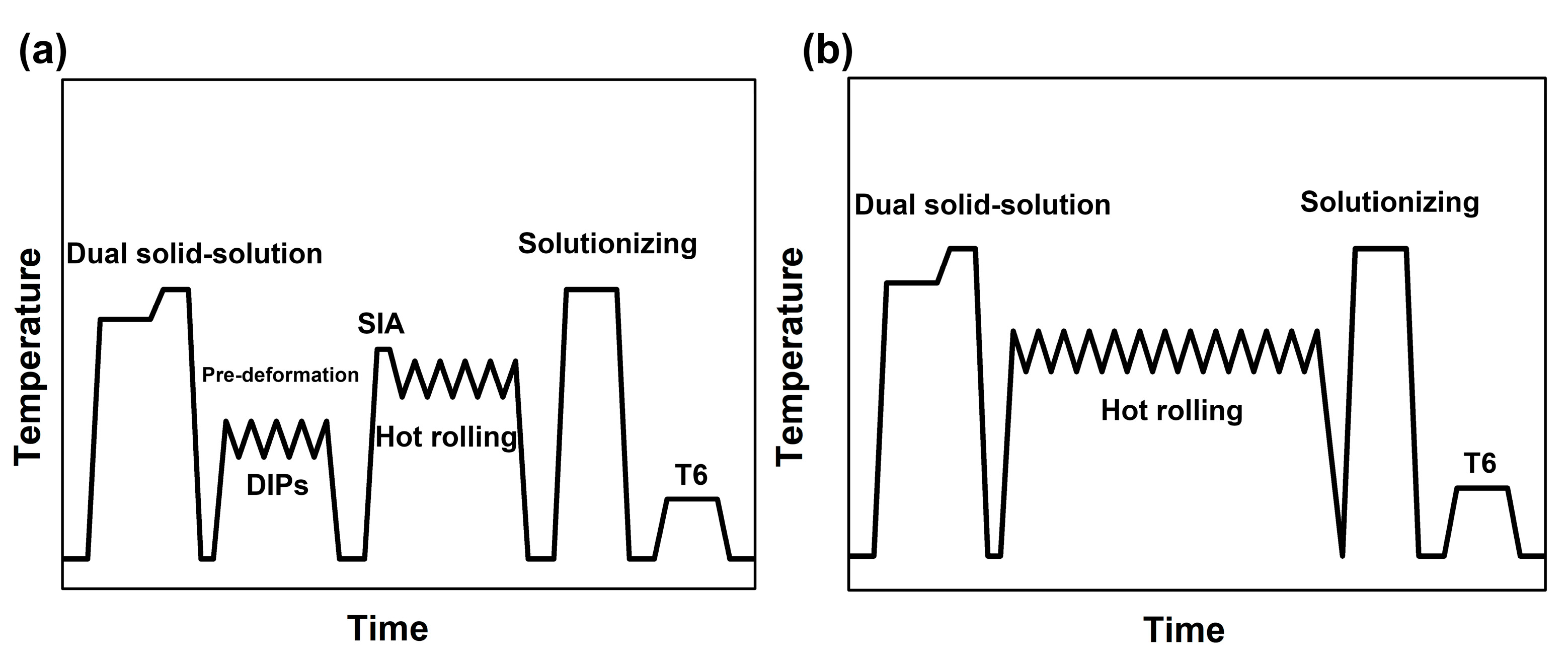
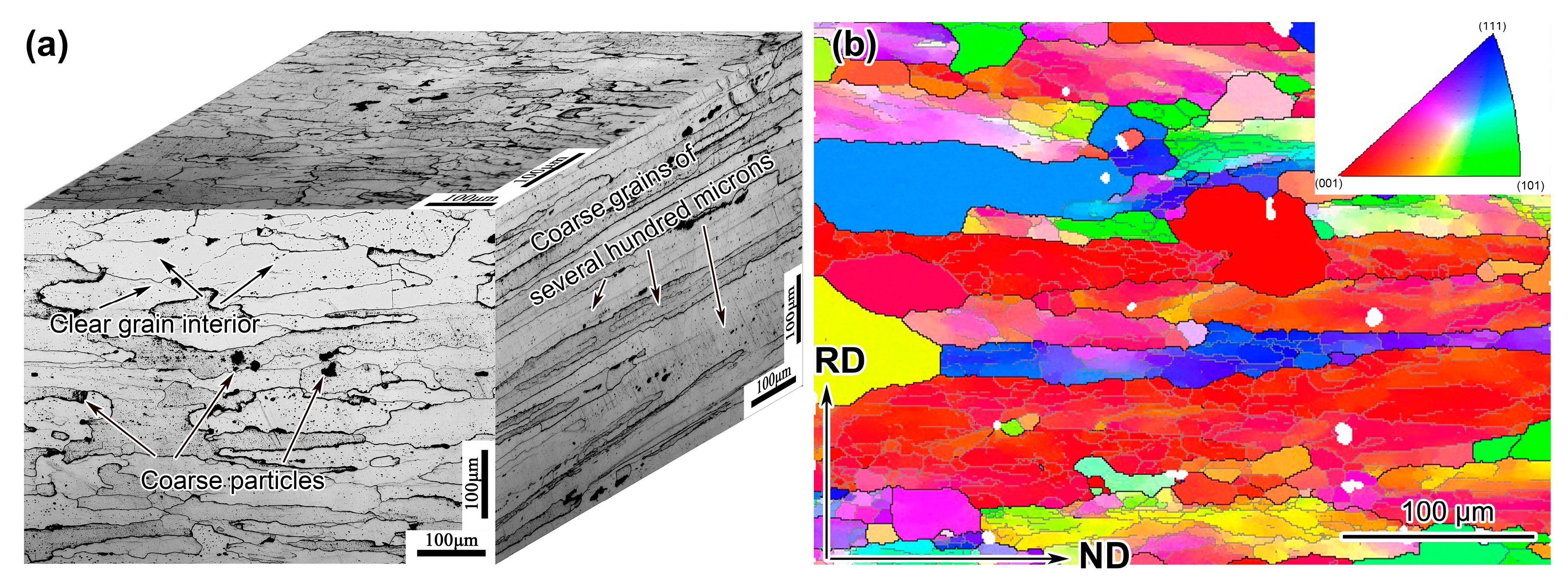
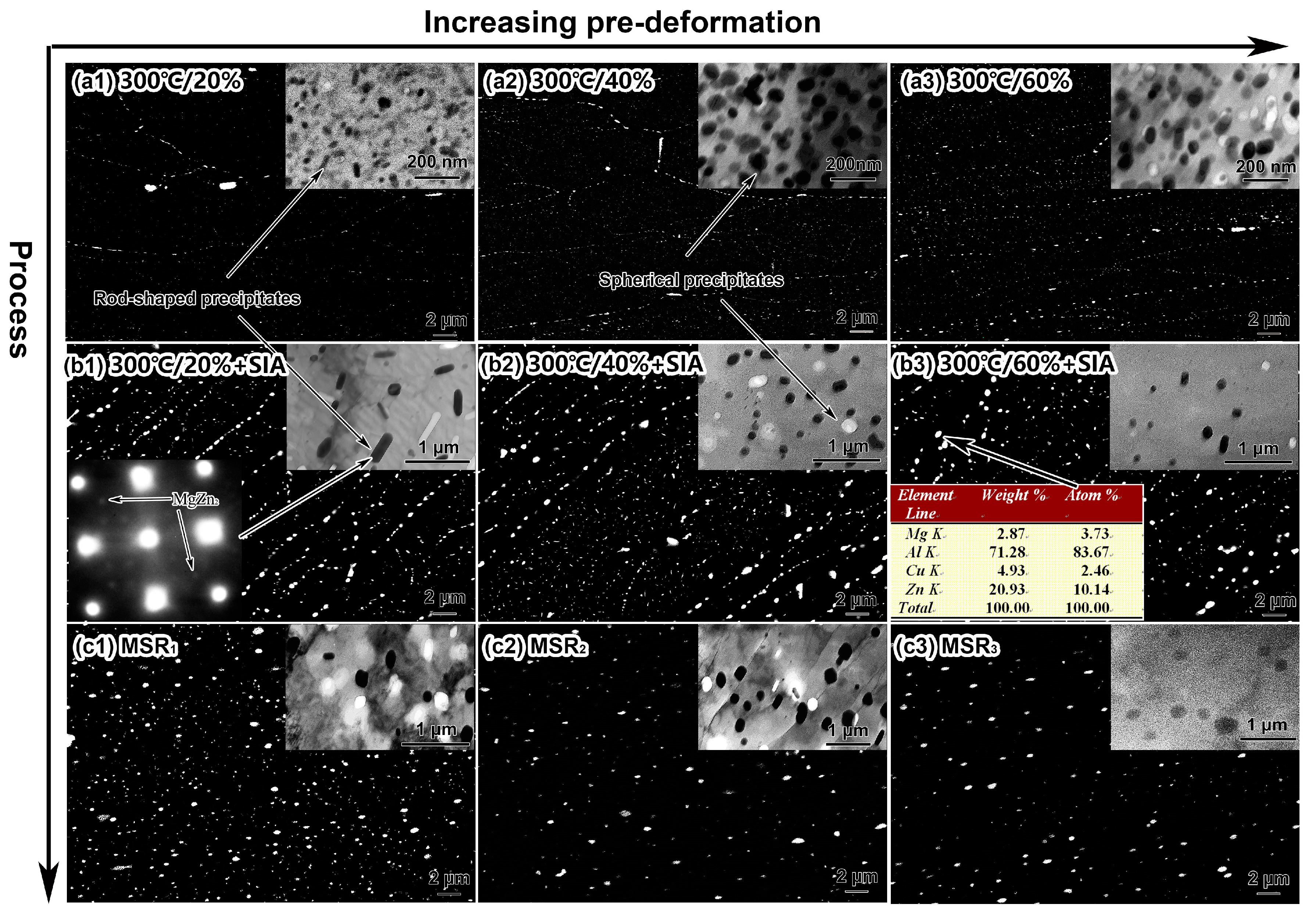


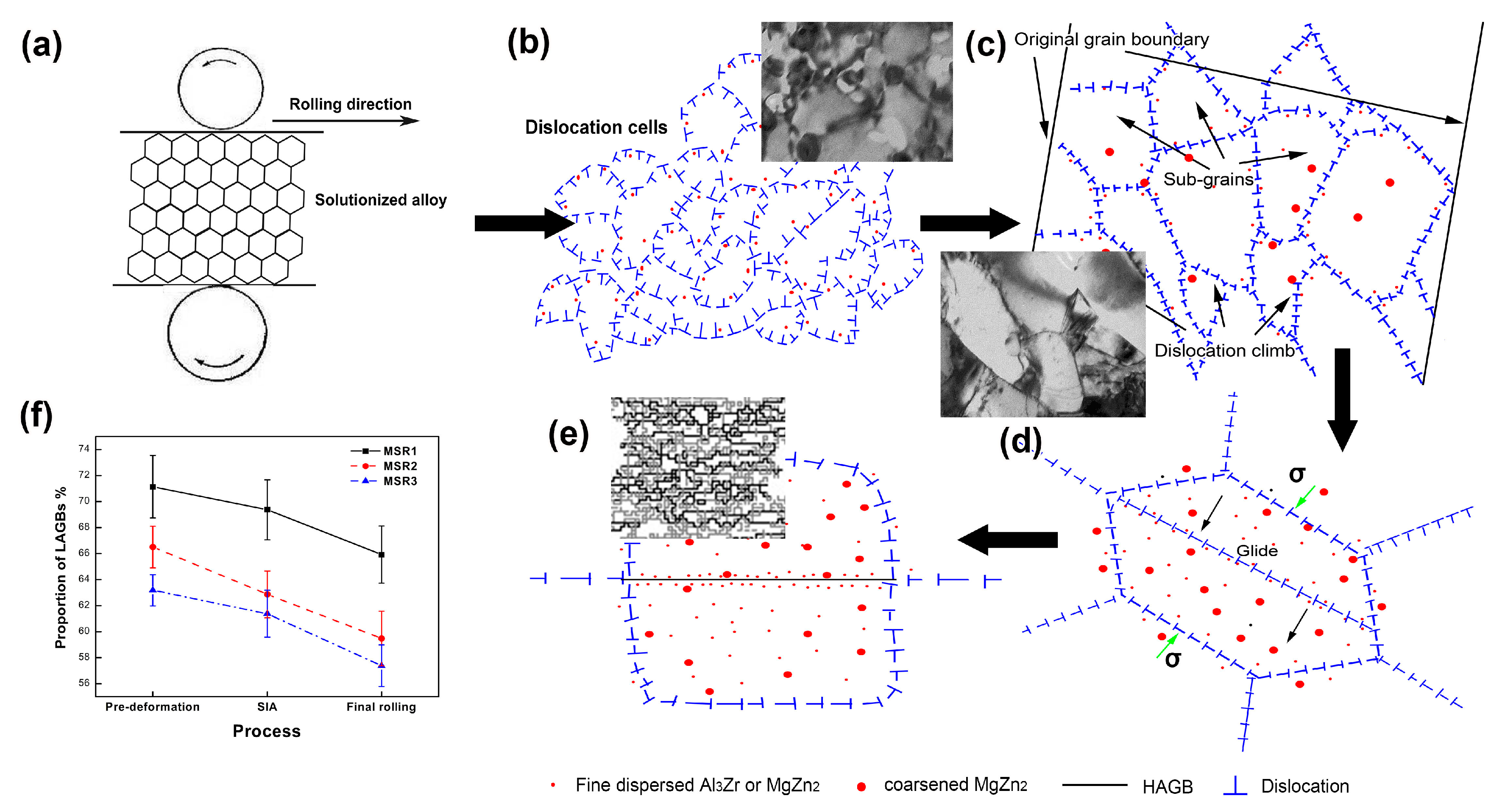
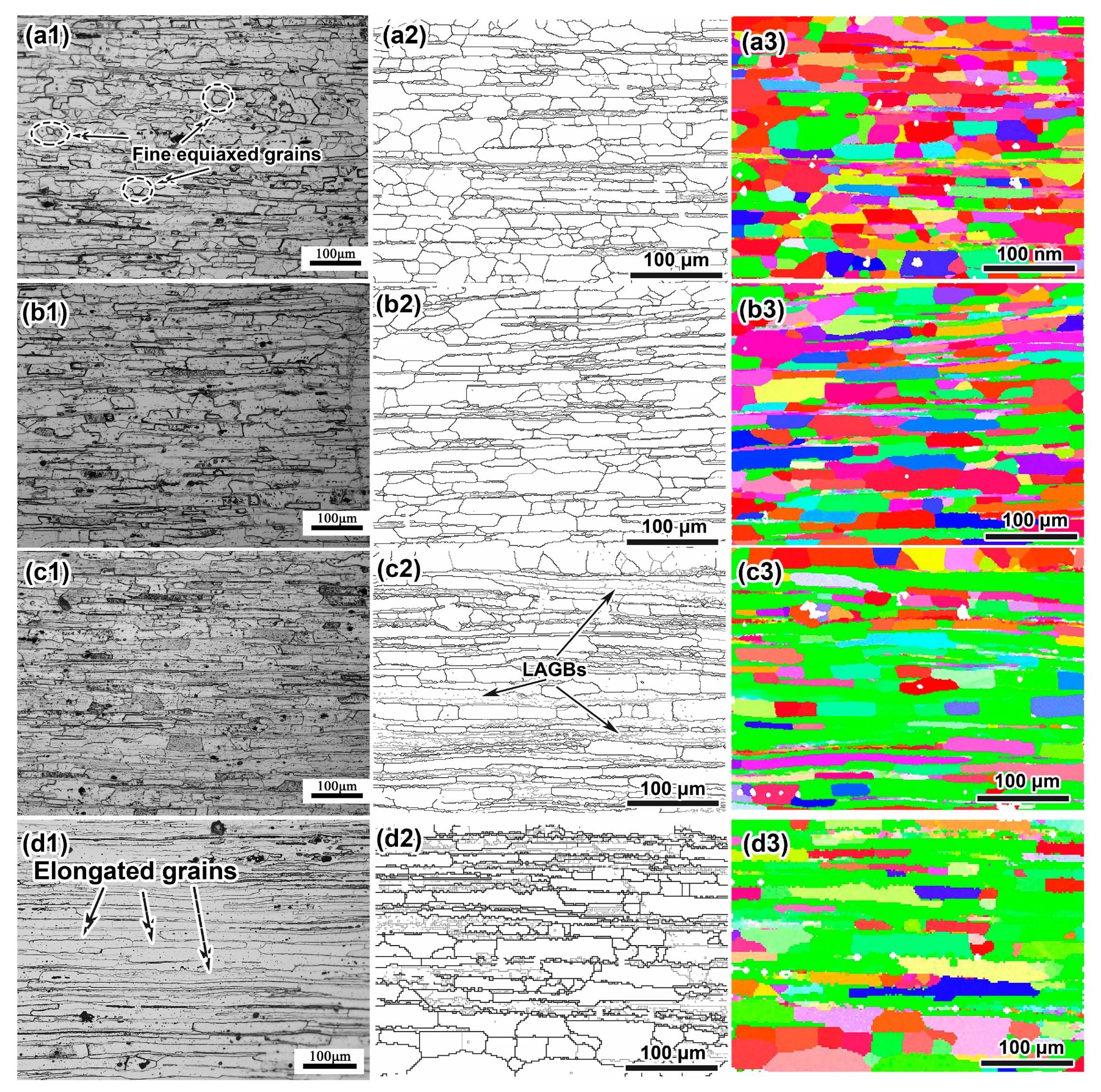
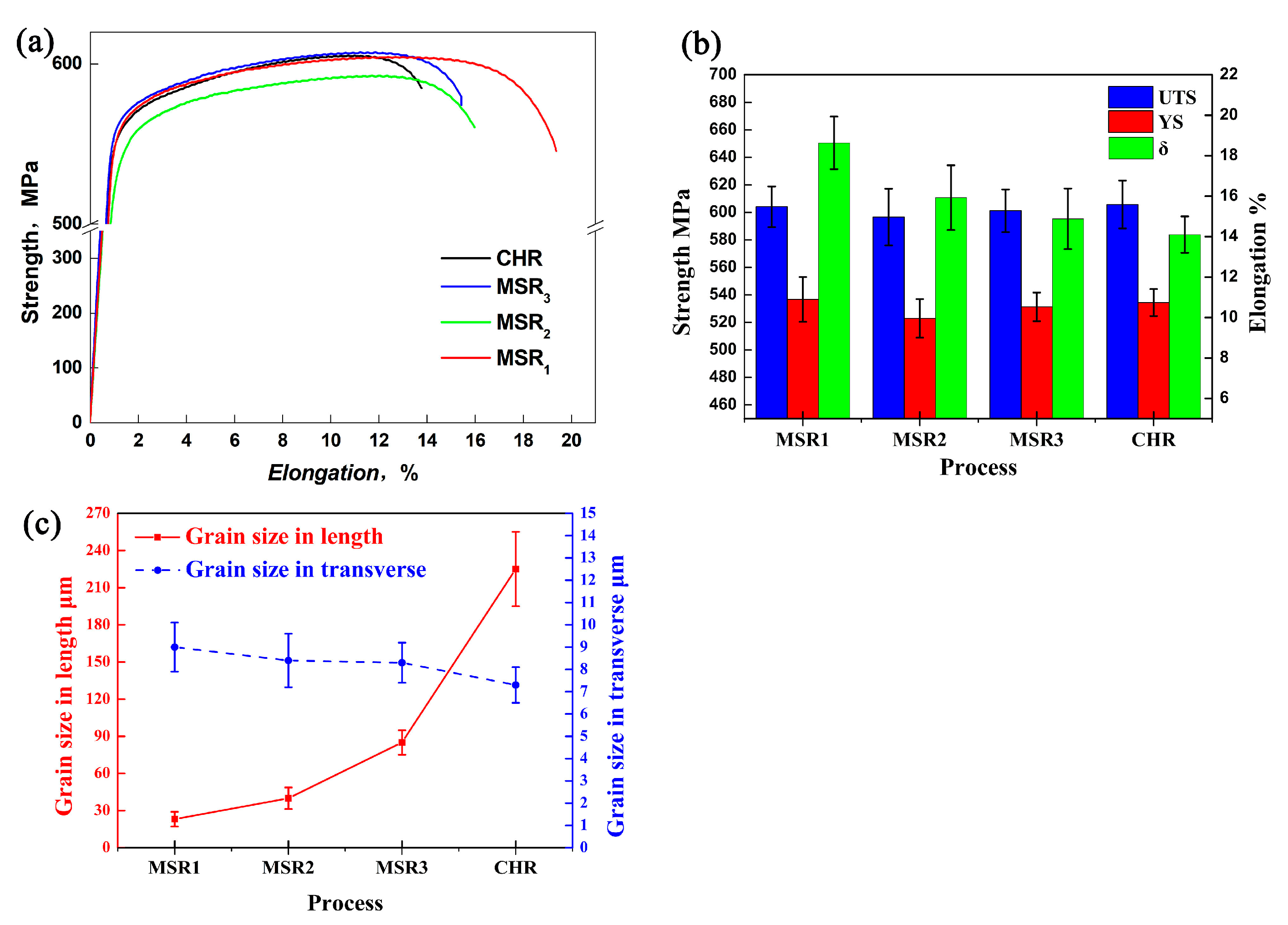
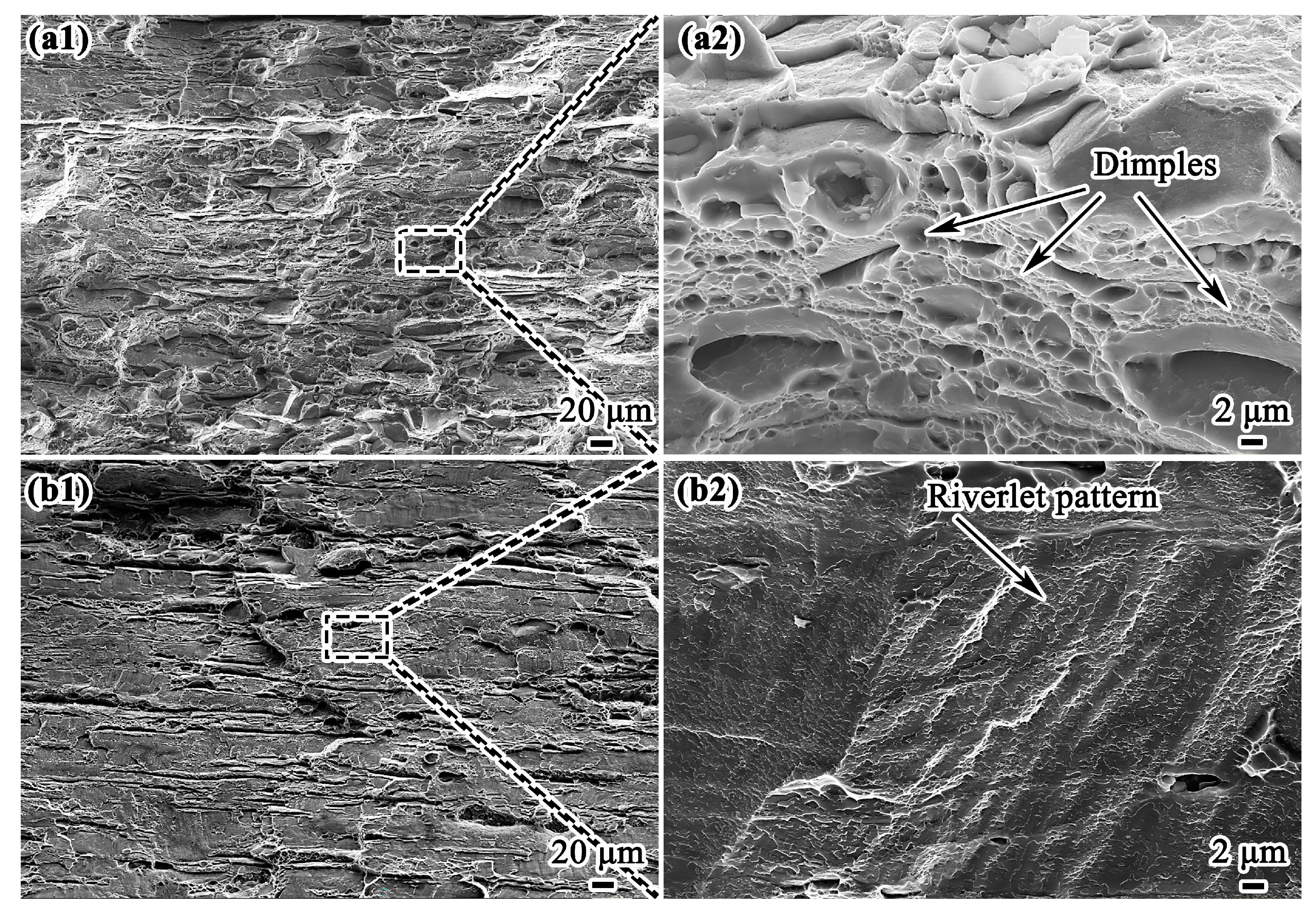
| Element | Zn | Mg | Cu | Zr | Ti | Fe | Si | Al |
|---|---|---|---|---|---|---|---|---|
| wt% | 8.38 | 2.07 | 2.31 | 0.13 | 0.16 | 0.092 | 0.056 | Bal |
| Process | Pre-Deformation | SIA | Final Hot Rolling |
|---|---|---|---|
| CHR | - | - | 400 °C/80% |
| MSR1 20 + 60% | 300 °C/20% 15→12 mm | 430 °C/5 min | 400 °C/60% 12→3 mm |
| MSR2 40 + 40% | 300 °C/40% 15→9 mm | 400 °C/40% 9→3 mm | |
| MSR3 60 + 20% | 300 °C/60% 15→6 mm | 400 °C/20% 6→3 mm |
Publisher’s Note: MDPI stays neutral with regard to jurisdictional claims in published maps and institutional affiliations. |
© 2020 by the authors. Licensee MDPI, Basel, Switzerland. This article is an open access article distributed under the terms and conditions of the Creative Commons Attribution (CC BY) license (http://creativecommons.org/licenses/by/4.0/).
Share and Cite
Zuo, J.; Hou, L.; Shu, X.; Peng, W.; Yin, A.; Zhang, J. Effect of Deformation on Precipitation and the Microstructure Evolution during Multistep Thermomechanical Processing of Al-Zn-Mg-Cu Alloy. Metals 2020, 10, 1409. https://doi.org/10.3390/met10111409
Zuo J, Hou L, Shu X, Peng W, Yin A, Zhang J. Effect of Deformation on Precipitation and the Microstructure Evolution during Multistep Thermomechanical Processing of Al-Zn-Mg-Cu Alloy. Metals. 2020; 10(11):1409. https://doi.org/10.3390/met10111409
Chicago/Turabian StyleZuo, Jinrong, Longgang Hou, Xuedao Shu, Wenfei Peng, Anmin Yin, and Jishan Zhang. 2020. "Effect of Deformation on Precipitation and the Microstructure Evolution during Multistep Thermomechanical Processing of Al-Zn-Mg-Cu Alloy" Metals 10, no. 11: 1409. https://doi.org/10.3390/met10111409
APA StyleZuo, J., Hou, L., Shu, X., Peng, W., Yin, A., & Zhang, J. (2020). Effect of Deformation on Precipitation and the Microstructure Evolution during Multistep Thermomechanical Processing of Al-Zn-Mg-Cu Alloy. Metals, 10(11), 1409. https://doi.org/10.3390/met10111409







